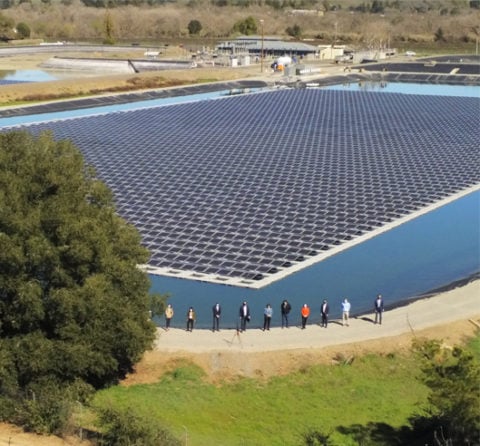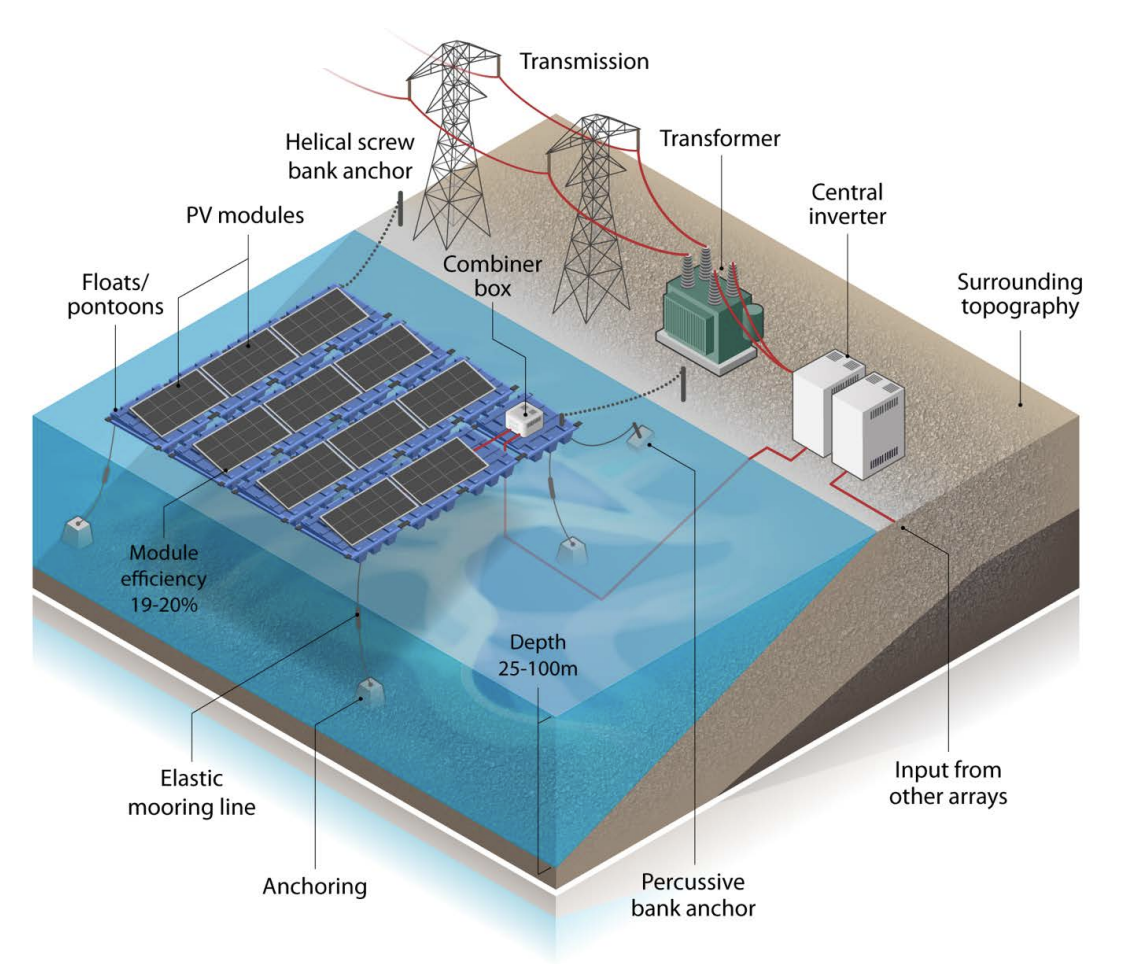You've probably heard about "Floating Solar" before - it's an intriguing and innovative concept. Floating Solar is also known as “Floatovoltaics” or “Floating Photovoltaics”, and is often abbreviated as “FPV”.
The general idea is: install solar, preserve land for other uses, and get water quality benefits at the same time.
However, is floating solar actually useful, and will it ever be deployed at scale? Can it avoid the fate of other clever-sounding technologies like "solar roadways" that never quite made it?
 Floating solar array on a water treatment pond in Healdsburg, CA. Credit: Ciel & Terre International.
Floating solar array on a water treatment pond in Healdsburg, CA. Credit: Ciel & Terre International.
Luckily, while still nascent (but growing) in North America, floating solar is already widespread in other areas of the world indicating its robustness. In particular, the technology has been widely adopted in East Asia where open land for ground mount solar is more scarce.
Again, the concept of floating solar is very simple: take standard solar panels (the same ones you might put on a roof or on a large solar farm), float them on a pond using the same material that is used in milk jugs, and anchor them in place. This anchoring is either to the bottom of the pond or to the sides of the pond (side-anchoring is more common for smaller bodies of water).
The solar panels shade the water, which lowers the temperature of the water by reducing sunlight exposure, and reduces evaporation both due to breaking the wind and preventing direct sunlight exposure. Reduced sun has side benefits for water quality; for instance solar arrays can reduce unwanted algae growth in the pond. The floats themselves can act as sunning spots for turtles or perching spots for birds, and the primary maintenance concern is cleaning bird waste from the panels.

Schematic of a typical floating solar system. Credit: NREL.
The system connects to inverters which are either on land (for smaller systems) or floating on platforms as well (for larger systems). From the inverters, the power needs to be delivered either ‘behind the meter’ to facilities onsite which can use the energy, or ‘front of meter’ directly to the grid via interconnection equipment.
 Floating solar array on a reservoir in Sayreville, NJ. Credit: Ciel & Terre International.
Floating solar array on a reservoir in Sayreville, NJ. Credit: Ciel & Terre International.
💰 Costs
While this all sounds great, what do these systems cost? Similar ‘flashy’ technologies like in-window or in-road solar have also been hyped up but are ultimately far too expensive to use except in prestige projects. The customers in our marketplace are businesses or municipalities - they generally need projects to pencil financially in order to proceed.
Floating solar does have some cost advantages: lower installation labor cost and less steel than carport (or even ground mount) systems. It also has some disadvantages: fewer knowledgable developers and high cost for the technology used to float the panels. Which of these effects predominate?
Luckily, in addition to government data, Station A runs a robust marketplace and thus has a wide provider network we can tap to determine the costs of various solar technologies in the C&I space. Using these resources, we’ve determined rough relative costs between the different options, shown below.
.png?width=716&height=365&name=Floating%20Solar%20costs%20compared%20to%20other%20technologies%20(3).png)
Costs of various solar technologies. See methodology for sources.
Floating solar is generally more expensive per-watt than rooftop solar or ground mount. However, it is less expensive than the very-common carport systems you see in parking lots across the country. Thus, in many circumstances the technology will make financial sense.
Keep in mind that, just like other technologies, as systems scale larger the costs per watt are reduced (due to economies of scale). Some larger floating solar projects are even approaching $1.00/W-DC.
Floating solar is generally more expensive per-watt than rooftop solar or ground mount. However, it is less expensive than the very-common carport systems you see in parking lots across the country. Thus, in many circumstances the technology will make financial sense.
How we got these numbers
- Using NREL’s 10 MW-DC floating solar vs ground mount data, we calculated the ratio of fixed costs (e.g. anything but modules and inverters) between the the two technologies. We then applied this scaling factor to 500 kW-DC ground mount NREL data to determine an estimated value for per-watt-DC costs for 500 kW-DC systems.
- We then verified with our provider network that these calculated values were within market range, as NREL numbers are not always reflective of true conditions in the market.
- Ground mount systems rely on NREL’s 2021 cost data (linked above) adjusted to USD 2023 values.
- Rooftop systems rely on recent Station A marketplace data, analyzed at a nationwide level.
- For carport systems, please see our prior blog post for the methodology.
🤔 When to choose floating solar
So if you do control a water body, when does it actually make sense to choose floating solar? There are a few ‘slam dunk’ situations for floating solar, but some prerequisites before you consider it as an option.
Prerequisites
- A still (non moving) body of water
While there is some precedent for canal-based and marine-based floating solar, generally these are more difficult situations. Canal-based systems are often built as canopies over the canal, and canal maintenance organizations in general are hesitant to approve them due to the perceived added complexity of maintaining the waterway.
- Restricted access to that body of water
Like other infrastructure (e.g. a dam), any solar system needs to be protected from boats or other potential human-caused damage. If it’s a fully-restricted body of water, that’s even better.
- No nearby open land or large rooftops
If there’s significant nearby open land, it’s likely that a ground mount system will be cheaper. While a floating system could work in that case as part of algae abatement, it’s just less likely to pencil compared to a ground mount system. The same goes for a nearby rooftop with ample space for a solar array; that rooftop array will likely be cheaper.
- No foreseen need to dredge the water body within the payback period (~10-15 years to be safe)
It is possible to remove the panels, dredge, and then return the panels to the body of water, but adds significant cost to the operation. Similar to roof replacements, adding in solar immediately after a water body is dredged could be a great idea.
Slam dunk scenarios
- If you’re already considering algae abatement or other sun protection infrastructure (e.g. a cover or shade balls)
If the body of water has an algae problem, using floating solar can be a great way to get revenue while solving the problem, rather than having to expend funds for protective infrastructure! As a fantastic example, the city of Healdsburg took advantage of this effect at their water treatment plant located in California.
- If there’s a load source adjoining the water body
If you can consume the electricity produced by the array on-site, rather than needing to export to the grid, the value of that electricity is drastically higher. This makes sites such as water treatment plants ideal for this type of solar - there’s usually a restricted-access pond with a large load source immediately adjacent to the pond.
An additional bonus comes from resiliency - if the system includes battery storage, then a solar system can potentially supply power to the load source in a grid outage scenario. Bonus points if that load source is critical infrastructure, as explored in this feasibility study.
- If your water supply is expensive or scarce, especially if in a high-evaporation environment
Adding a floating solar system reduces evaporation on the pond both by shading from the sun and protecting from the wind. A floating solar system can save valuable water and demonstrate that your organization is working to reduce water loss.
Unfortunately, the science of evaporation is not very mature, so exact water savings numbers are hard to come by and use quantitatively to justify investment; if using this justification, we recommend treating it more as a qualitative benefit.
💬 Conclusion
Floating solar is a great option for municipalities and other organizations, given an acceptable site. In the best cases, these arrays can solve real water-quality issues while producing local, clean power at cheaper rates than available from a utility.
Floating solar is economical and growing fast, and is not just a false hope like solar roadways or other flashy concepts.
In some cases, the project is a slam dunk - contact us and let’s take it to the market! For other sites, we’re happy to provide feasibility studies and a free 30 minute consultation to see if floating solar might work for your site.
In any case, this is a sector we’re watching and excited about. Floating solar is economical and growing fast, and is not just a false hope like solar roadways or other flashy concepts. We’re excited to help commercial and industrial customers like yourself make the best use of your sites, whether that’s via the rooftop, parking lot, nearby field, or yes, even a pond onsite.